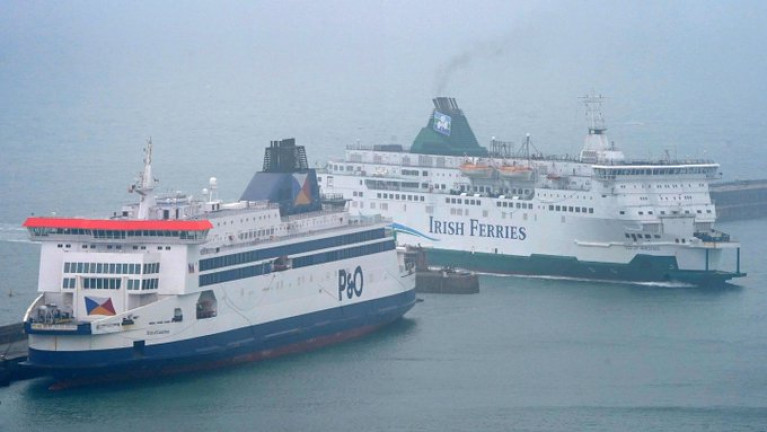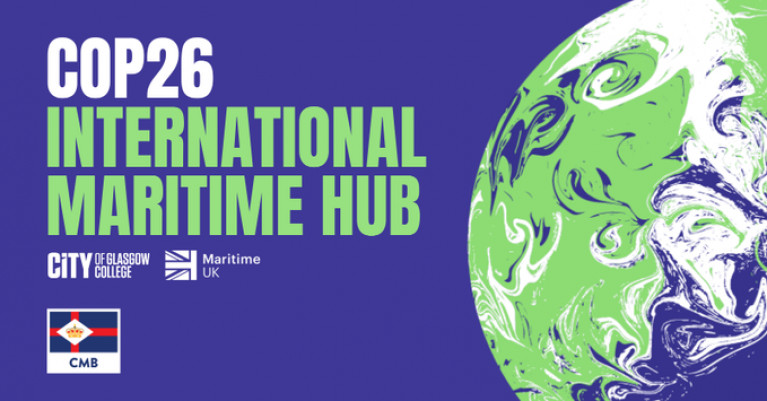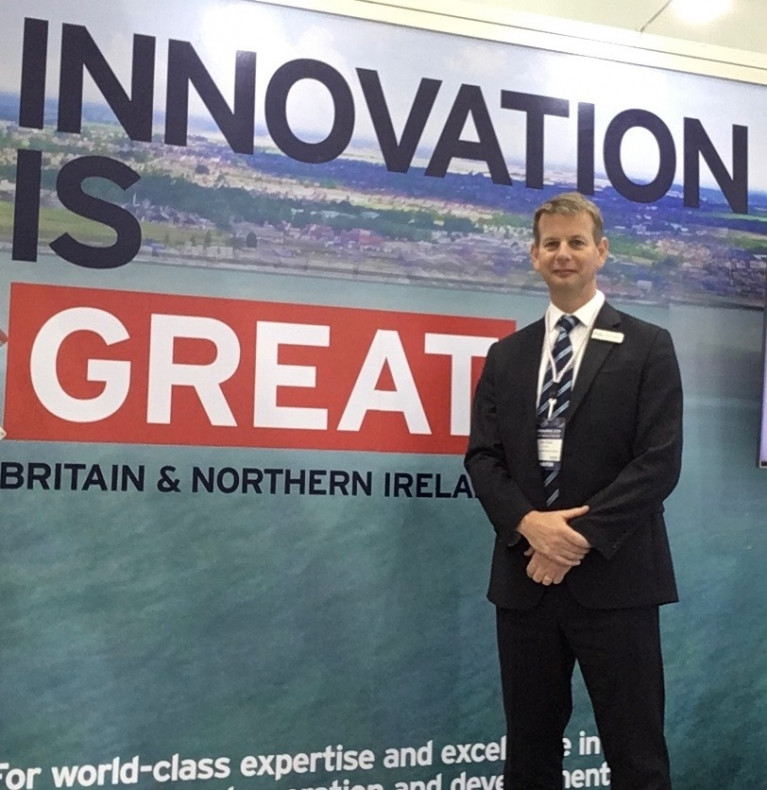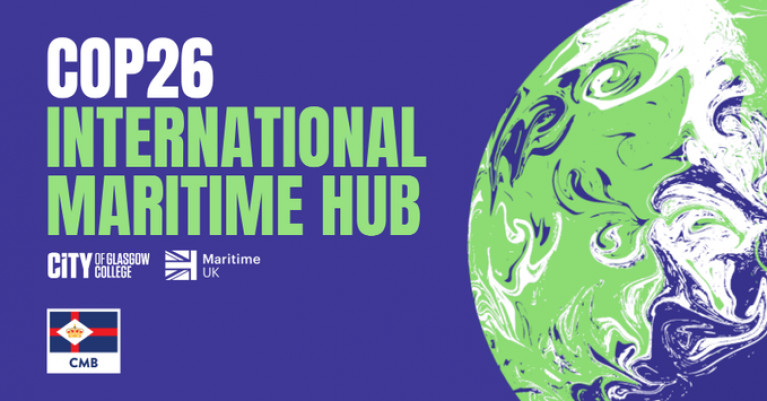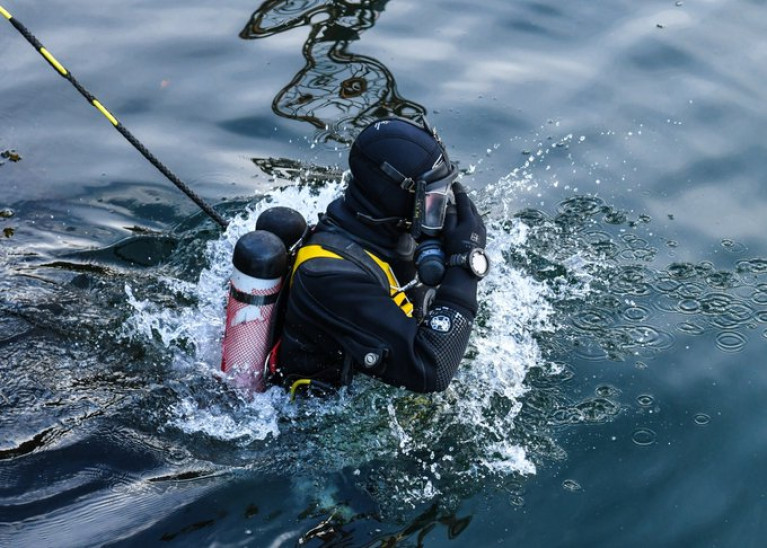Displaying items by tag: COP26
Strait of Dover Ferries Will Go Electric, Say Operators
A radical and ambitious proposal to turn the Dover Strait green and to allow only fully electric ferries on the short-sea English Channel crossing will be put to the government today.
The plan is for the routes between Dover and Calais and Dunkirk to become the first zero-carbon shipping corridor in the world, with a new generation of ferries making the 22-mile crossing on battery power and the ports replacing their fuel bunkers with industrial-size ship recharging points.
If the proposal is agreed, it is likely that in time there will be a corollary mandate to demand that heavy goods and passenger vehicles using the port and ferries also will have to be lower-emission.
To read more The Times, has further coverage.
The UK-France route is operated by DFDS, P&O Ferries and Irish Ferries which entered the Dover-Calais market almost a year ago.
Ireland has joined a new alliance of governments that aims to phase to out oil and gas production in line with the existing Paris agreement on climate change.
Minister for Environment, Climate and Communications Eamon Ryan confirmed Ireland’s support for the Beyond Oil and Gas Alliance (BOGA) at the COP26 conference on climate change in Glasgow on Thursday.
He described BOGA as “a first-of-its-kind alliance of governments that are determined to set an end date for oil and gas exploration and extraction”.
The alliance is jointly chaired by Costa Rica and Denmark, and membership includes France, Greenland, Quebec, Sweden, Wales.
California, USA, and New Zealand are associate members of the alliance.
“Ireland is leading the way in incentivising the transition to renewable energy and putting ourselves on a pathway to net-zero, by legislating to keep fossil fuels in the ground,” Ryan said.
“ The decision we have made today, to join BOGA, sends a powerful message that we are moving irrevocably away from fossil fuels towards a renewable future – both in Ireland and internationally,” he said.
“Through the Climate Act 2021, Ireland has closed the door on new exploration activities for oil and gas,” he said.
“ There is no longer a legal basis for granting new licences. In line with Irish government policy of keeping fossil fuels in the ground, we are also currently legislating to prohibit exploration for and extraction of coal, lignite and oil shale,” Ryan continued.
“ As a core member of BOGA, Ireland will lead by example and share our experience of legislation so that we can all move towards a fossil-free future,” he said.
The BOGA declaration signed by founding members pledges to support “a socially just and equitable global transition”.
Core members, including Ireland, commit to ending new concessions, licensing or leasing rounds, and promote dialogue on the need for a managed and just phase-out.
The alliance states that it recognises that members may be locked into granting certain permissions, due to existing contractual/legal commitments.
It seeks to “set a clear direction of travel, taking an ambitious ‘glide path’ approach to phasing out production, rather than an impossible ‘nose-dive’”, Ryan’s department said.
“By prohibiting offshore oil and gas exploration, not only are we doing what we need to do to address climate change, but we are also protecting our biodiversity which is intrinsically linked to climate change,” Ryan said.
He said he looked forward to “using the platform that BOGA will provide to raise the profile of international dialogues on oil and gas phase-out”.
'Clydebank Declaration' Signed at COP26 for Green Shipping Corridors
At the COP26 Conference in Glasgow today, the UK has announced the launch of the Clydebank Declaration on Green Shipping Corridors.
Signatory states (including Ireland) declared their ambition and intent to support the establishment of green shipping corridors – zero-emission shipping routes between 2 ports.
The naming of the 'Clydebank Declaration' pays tribute to the heritage of the City of Glasgow and the River Clyde where the Declaration was signed.
The Declaration sits within the Zero-Emission Shipping Mission and is designed to complement work at the International Maritime Organization to enable zero-emission shipping.
Clydebank Declaration
We, the Clydebank Declaration signatories: Recall the long-term temperature goal of the Paris Agreement to hold the increase in the global average temperature to well below 2°C above pre-industrial levels and pursue efforts to limit the temperature increase to 1.5°C above pre-industrial levels.
Note the International Maritime Organization (IMO)’s adoption of the Initial IMO Strategy on Reduction of Greenhouse Gas Emissions from Ships, Resolution MEPC.304(72), which aims to align international shipping with the aforementioned temperature target.
Emphasise the importance of pursing efforts to limit the increase in the global average temperature to 1.5°C above pre-industrial levels, to have a greater chance of significantly reducing the risks and impacts of climate change on countries, in particular least developed countries and small island developing states.
Recognise the benefits of pursuing synergies between decarbonisation and clean air policies in shipping, and building on existing measures related to the reduction of pollution from ships under the International Convention for the Prevention of Pollution from Ships (MARPOL).
Express great concern regarding the findings from the Fourth IMO Greenhouse Gas Study 2020, which estimates that if no further action is taken, international shipping emissions are expected to represent 90% to 130% of 2008 emission levels by 2050.
Express great concern also regarding the findings of the IPCC Working Group I contribution to the Sixth Assessment Report (2021), which states that global warming of 1.5°C and 2°C will be exceeded during the 21st century unless deep reductions in carbon dioxide (CO2) and other greenhouse gas (GHG) emissions occur in the coming decades, and hence, endorse the need for international shipping to keep accelerating its level of action.
Equally recognise that a rapid transition in the coming decade to clean maritime fuels, zero-emission vessels, alternative propulsion systems, and the global availability of landside infrastructure to support these, is imperative for the transition to clean shipping.
The signatories of this Declaration assert the need for the formation of an international coalition between ambitious governments, to act together and demonstrate that maritime decarbonisation is possible, while unlocking new business opportunities and socioeconomic benefits for communities across the globe.
Mission statement
The signatories of the Declaration are to support the establishment of green shipping corridors – zero-emission maritime routes between 2 (or more) ports.
It is our collective aim to support the establishment of at least 6 green corridors by the middle of this decade, while aiming to scale activity up in the following years, by inter alia supporting the establishment of more routes, longer routes and/or having more ships on the same routes. It is our aspiration to see many more corridors in operation by 2030. We will assess these goals by the middle of this decade, with a view to increasing the number of green corridors.
In the pursuit of these goals, with reference to the approach(es) set out in Annex A, signatories pledge to: facilitate the establishment of partnerships, with participation from ports, operators and others along the value chain, to accelerate the decarbonisation of the shipping sector and its fuel supply through green shipping corridor projects identify and explore actions to address barriers to the formation of green corridors. This could cover, for example, regulatory frameworks, incentives, information sharing or infrastructure consider the inclusion of provisions for green corridors in the development or review of National Action Plans work to ensure that wider consideration is taken for environmental impacts and sustainability when pursuing green shipping corridors.
Annex A
Signatories are to facilitate partnerships to establish green shipping corridors, in which: Two or more signatories to the Declaration identify and take steps with relevant willing ports, operator(s) and others along the value chain to decarbonise a specific shared maritime route
A signatory to the Declaration takes steps with relevant willing ports, operator(s) and others along the value chain to decarbonise a specific domestic maritime route within the jurisdiction and control of a signatory.
Voluntary participation by operators is a significant element for successful green shipping corridors.
For greater clarity, all vessels transiting a green corridor would not be required to be zero emissions or to participate in the partnerships.
In supporting the establishment of green corridors, signatories recognise that fully decarbonised fuels or propulsion technologies should have the capability to not add additional GHGs to the global system through their lifecycle, including production, transport or consumption.
Signatories of Nations
- Australia
- Belgium
- Canada
- Chile
- Costa Rica
- Denmark
- Fiji
- Finland
- France
- Germany
- Republic of Ireland
- Japan
- Republic of the Marshall Islands
- Netherlands
- New Zealand
- Norway
- Sweden
- The United Kingdom of Great Britain and Northern Ireland
- The United States of America
For more from related COP International Maritime Hub page, click here.
Ports Group in UK Commits to Net Zero Emissions by 2040
The Peel Ports Group (see stake deal) has committed to becoming a net zero port operator by 2040, a decade ahead of the UK Government’s national decarbonising targets.
The UK's second largest port operator, headquartered in Liverpool, owns some of the UK’s largest and most important ports including the Port of Liverpool, Clydeport and London Medway, and is the first major port group to convey such ambitious plans towards tackling climate change.
The group has unveiled a number of initiatives and investments to help drive a more sustainable agenda and reach the net zero milestone by 2040 across all of its locations in the UK and Ireland (Dublin Port's MTL Terminals adds Afloat).
As part of COP26, Peel Ports Group is hosting two workshops at the International Maritime Hub, in collaboration with the British Ports Association, the UK Major Ports Group, Maritime UK and City of Glasgow College.
By the end of this year, Peel Ports aims to have 50% of its vehicle fleet replaced with electric cars, with the remainder in place by December 2022, and is currently undergoing trials of greener fuels and electric alternatives for the future of its operational machinery and equipment.
The port operator views investment as being the key to resiliency and has been passionate about developing a sustainable future for the supply chain for many years.
Peel Ports has invested over £1.2 billion across the last decade on sustainable infrastructure and technology to future proof its operations including the delivery of energy efficient cranes, LED lighting and choosing sustainable, low emission equipment and suppliers.
Mark Whitworth, CEO of Peel Ports said: Our ports provide critical infrastructure as the UK’s gateways for food, medical, energy and fuel supplies. It is therefore important that as a responsible business we incite positive change in the UK’s logistics market to tackle climate change
“We understand and acknowledge our responsibility to minimising the environmental impact of our operations for the benefit of the planet, while also ensuring the smooth continuation of the supply chain”
“Our vision for the future of our business, our people, our customers and our communities is ambitious. Ultimately, our net zero plans will work towards achieving long-term sustainable growth that has a positive impact on the environment, as well as regional and local economies for generations to come.”
The port operator is also promoting the benefits of ports closer to the end destination, in order to reduce emissions, as well as introducing major new rail services for better connectivity, taking tonnes of freight off the road.
It will also continue to support the changing energy markets with both offshore and onshore wind sites available across its various locations.
Furthermore, in order to future-proof its carbon neutral needs, the group has also created an Innovation Forum which seeks to answer some of the biggest questions around the reduction of emissions. The forum tracks down answers from universities, entrepreneurs and start-ups, which in turn pitch their ideas and solutions. The best of these can be deployed at scale with the necessary investment from the business.
Peace Boat, the Japan-based international NGO that works to promote peace, human rights and sustainability is taking part in COP26's Virtual Ocean Pavillion which includes their EcoShip project, a transformational programme to construct the planet’s most environmentally sustainable cruiseship.
In this year's COP conference, Peace Boat and Ecoship will be partnering with other civil society organizations to call for increased ambition on climate action, participating in events in the UNFCCC administered Blue Zone, in public areas of the city of Glasgow, and virtually with a booth at the COP26 Virtual Ocean Pavillion.
The Pavillion will feature the 'Overview of Peace Boat Engagement at COP 26' which also focuses on the Peace Boat Ecoship – Sailing for the UN's Sustainable Development Goals (SDGs) and Climate Action. This online event is take place today between 1:15 – 1:45 PM at the SDG Pavilion, Blue Zone.
The EcoShip - below is an outline of the newbuild project.
The Ecoship is a 60,000 ton, 2000 passenger capacity, nature-inspired vessel with a 40% reduction in CO2 emissions achieved through renewable technologies and energy efficiency.
Closed water and closed waste loop systems onboard will mean zero discharge and close to zero waste to reduce marine pollution.
The Ecoship will be the platform for Peace Boat’s round-the-world educational voyage carrying 6,000 people per year, host exhibitions on green technology in up to 100 ports per year; and serve as a floating sustainability laboratory contributing to research on the ocean, climate and green marine technology.
The ship also will create awareness and encourage active engagement with the challenges embodied in the UN’s Sustainable Development Goals (SDGs).
Building the planet’s most environmentally sustainable ocean-going cruise ship implied a radically different approach, with particular emphasis on the choice of technologies. The design of the ship was finalized after a three-year, whole-system design process that brought together experts from fields as diverse as naval architecture, renewable energy, and biophilic and biomimetic design.
The goal – to define the specifications for a vessel where radical energy efficiency and maximised use of renewables combine with a programme of activities and actions to deliver a highly visible demonstration of sustainability-in-action in every port that it visits.
Learn more about Peace Boat's Ecoship project through their dedicated website here.
Trade Body in UK Survey Reveals ‘Big Uptick’ in Maritime Engineering Firms Embracing Decarbonisation
A UK trade body, representing Britain’s shipbuilding, maritime engineering and science sectors, is reporting a big increase in the number of companies embracing the decarbonisation agenda.
The Society of Maritime Industries (SMI) is issuing the findings of its ‘Green Maritime Survey’ as the COP26 climate change summit begins in Glasgow.
The survey paints a picture of positive change in the industry with 85pc actioning green initiatives, two thirds actively involved in green research and developing green technologies and 78pc running incentives for staff to lower their environmental impact.
A further 78pc said the environmental agenda is impacting the way they run their business with 93pc saying their customers are increasingly aware of the environmental impact of operations. However, two thirds reported the Government is not doing enough to enable them to go green. (For case studies, click this link and scroll down the page).
SMI Chief Executive Tom Chant said the survey showed businesses are taking action ‘right here and now’ and there is ‘enormous desire and passion’ in the industry to support net zero ambitions.
“Small businesses are the backbone of the maritime engineering and science sectors and for the energy majors and primary contractors like shipbuilders to meet net zero targets they need their supply chain to decarbonise at speed too,” he said. “This survey shows the efforts being made to innovate and adapt to meet green targets with companies both developing new products and becoming more environmentally aware in their day-to-day operations with more initiatives like recycling and cycling to work schemes.”
However, Mr Chant said barriers to going green remained such as red tape around R & D credits.
“It is brilliant to see Government giving a higher profile and greater recognition to maritime particularly in the last few years,” he said. “We also welcome the extra funding awarded by the Chancellor Rishi Sunak in the budget for research around the Clean Maritime Demonstration Competition (see notes to editors). But one message we are hearing loud and clear is the need to slash back on red tape around grants. Too often the red tape makes it too onerous for busy companies to apply for funding.”
Mr Chant said another major issue for its members is the lack of incentive to invest in decarbonising the buildings they lease.
“Many of our members want to invest in renewable energy heating sources and incentives like electric charging points but the pay-back period is often longer than their leases which are typically three to five years,” he said. “So there is reluctance to invest in ‘greening’ a building they do not own and may have to move out of. With properties being a big part of companies carbon footprint this pain point is important and requires swift Government action. We want to see more incentives for landlords and tenants to work together to green commercial properties as the desire from our members is very much there.”
Relay4Nature, an initiative by The Ocean Race and UN Special Envoy for the Ocean, Peter Thomson, is at the UN Climate Change Conference in Glasgow, COP26, to highlight the critical role the ocean plays in mitigating climate change and to call for world leaders to take urgent action to protect it.
The Relay4Nature baton, Nature’s Baton, was passed from the UN Secretary-General’s Special Envoy for the Ocean, Ambassador Peter Thomson to Vel Gnanendran, climate and environment director at the Foreign Commonwealth and Development Office, on the deck of the iconic tall ship Glenlee on the banks of the River Clyde in Glasgow on the first day of the world’s crucial climate change conference (Sunday 31 October).
The Ocean Race, together with Ambassador Thomson, created Relay4Nature earlier this year to help ensure that the ocean is central to global discussions affecting the planet’s future.
Nature’s Baton symbolises the fact that the world’s existential challenges of climate change and biodiversity loss are inseparably linked with the state of the ocean’s health.
‘The science tells us that we must protect 30% of the ocean by 2030. I think that is the very least we should be doing’
Receiving the baton on behalf of COP26’s landmark event, Vel Gnanendran said: “The ocean is critical to life. About three billion people in the world depend on the ocean. It is critical to livelihoods, biodiversity and saving our planet. The science tells us that we must protect 30% of the ocean by 2030. I think that is the very least we should be doing.
“I hope that we can see governments and non-governmental players all committing to take action to protect the oceans but not only taking the action but by putting the finance behind those actions.
“It is a real honour to receive Nature’s Baton on behalf on the UK COP26 Presidency and I really want to commend everyone involved in Nature’s Baton and the baton Relay for raising the profile of the ocean and galvanising actions around protecting it.”
Ambassador Thomson said that Nature’s Baton is giving the ocean a voice at crucial environmental conferences and is “part of an international effort to break down the silos that have often impaired the outcomes of these conferences. Relay4Nature is demonstrating connectivity, and underlining that our planetary problems and solutions all stem essentially from the same universal activities of humankind.”
Relay4Nature will feature throughout COP26, collecting and sharing messages from delegates about the action that world leaders need to take to protect the planet.
The Ocean Race and Ambassador Thomson will host a side event next Monday 8 November where, along with special guests, they will analyse the ocean’s role in the global negotiations so far.
The Relay4Nature initiative is supported by 11th Hour Racing, founding partner of the Race Sustainability Programme and premier partner of The Ocean Race.
‘The ocean may be a victim of the climate crisis, but it also holds the solutions. In fact the ocean is a true climate hero’
Richard Brisius, race chairman of The Ocean Race, said: “Climate change is taking a devastating toll on our blue planet. Seas are becoming warmer, more acidic and levels are higher, significantly impacting not just the species that live in them but humans, too.
“The ocean may be a victim of the climate crisis, but it also holds the solutions. In fact the ocean is a true climate hero. It provides half of the world’s oxygen, locks away a significant amount of carbon dioxide and absorbs heat, making it our most crucial ally in the fight against climate change.
“Through Relay4Nature we want to highlight that it is absolutely critical that the ocean has a seat at the negotiation table at COP26.”
COP26 takes place six years after the milestone Paris Agreement, which set out the critical emissions reduction targets the world needs to meet in order to avoid catastrophic climate change. From now until next Friday 12 November, leaders from across the world will attend the conference in Glasgow where it is expected that commitments will be made for more ambitious and decisive action.
Ahead of COP26, messages have been collected by Relay4Nature from a diverse mix of heads of state, ministers, business leaders, sailors and ocean lovers, including HSH Prince Albert of Monaco; the European Commissioner for Environment, Virginijus Sinkevičiusl and the UN High Level Climate Action Champion for COP26, Nigel Topping.
Each baton holder is asked to share their greatest concern related to the future of the planet and an ask to world leaders on the vital action required. Their messages are carried within the baton.
As well as connecting the major challenges to the planet, Nature’s Baton links the world’s major environmental conferences. It played a significant role at IUCN World Conservation Congress in Marseille in September. And following COP26, will make its way to UN Environment Assembly in Nairobi in March 2022, the UN Biodiversity Conference in Kunming in April and UN Ocean Conference in Lisbon in June.
The baton was also passed between sailing teams during the inaugural edition of The Ocean Race Europe earlier this year. It reached Glasgow following a six-day cycling relay from Southampton, on England’s south coast, to Scotland, organised by GAC Pindar, official logistics provider of The Ocean Race 2022-23, with support from Volvo Cars, premier partner of the race, who supplied two hybrid support vehicles for the relay.
Maritime UK Announces Events at COP26 to Showcase Sector’s Green Leadership to the World
Maritime UK has announced a COP26 programme, in partnership with the City of Glasgow College, to showcase the country’s global leadership in the shipping industry’s transition to Net Zero.
- IMO Secretary-General, Ministers and a VVIP to speak at flagship reception attended by maritime leaders
- Clean Maritime Demonstration Competition (CMDC) winners’ event set to demonstrate UK green maritime innovation
- Maritime Skills Commission will also chart skills needed to drive net zero transition
- Cutting-edge companies to showcase new clean vessels for offshore market
The programme will be delivered at “The International Maritime Hub”, located at the City of Glasgow College’s Riverside campus.
Winners of the government’s recent Clean Maritime Competition Demonstration (CMDC), which saw £23 million awarded to projects developing technology for vessels, will be provided a platform to demonstrate their innovation.
The Maritime Skills Commission will also host a forum for industry leaders to discuss how the UK’s sector will ensure the skills are in place to support the transition to net zero.
A reception will also be held with the IMO Secretary-General, Ministers and maritime CEOs in attendance. The invite-only event will be attended by Maritime UK members, IMO representatives and local Scottish maritime businesses.
Sarah Kenny OBE, chair of Maritime UK, said: “Our programme for COP26 will bring the sector together to showcase best practice and accelerate progress towards the decarbonisation of the sector.
“Through showcasing cutting-edge projects and convening the global industry to discuss this greatest of shared missions, we aim to set the agenda in Glasgow for green maritime.
“Following last week’s welcome Net Zero Strategy, we will also send a clear message to the UK government, highlighting how through closer collaboration, and further co-investment, we can meet the UK’s net zero target together.”
Other events over COP26 at the International Maritime Hub include the Mersey Maritime and Scottish Marine Cluster Breakfast Meeting, and ‘Get set for Workboat 2050’ hosted by the Workboat Association.
The Hub’s Platinum Sponsor is leading Belgian shipping firm Compagnie Maritime Belge, and Bronze Sponsors are Ecospeed Marine, the Port of Tyne and the American Bureau of Shipping (ABS).
Paul Little, Principal at City of Glasgow College, said: "As one of the leading maritime institutions across the globe, we are delighted to be working in partnership with Maritime UK to formally launch our International Maritime Hub here at our Riverside Campus in Glasgow.
“As this great city prepares to host COP26, when world leaders meet and agree on tackling climate change, we will be showcasing the latest technologies and innovation that the maritime sector has to offer."
Alexander Saverys, CEO at Compagnie Maritime Belge, added: “We are excited to be present at the International Maritime Hub during COP26. It’s an opportunity to showcase our many concrete hydrogen solutions for the shipping industry and engage with all the stakeholders on how to fast-track the deployment of green applications.”
Police Divers In Scotland Search River Clyde Ahead of COP26 Climate Change Summit
Police divers in Scotland are searching the River Clyde as part of the security operation in the run up to the Cop26 climate change conference in Glasgow.
As The Herald reports, specialist officers, who can search in confined spaces as well as capture underwater footage, will be patrolling the river and its banks ahead of the United Nations summit which runs from October 31 to November 12.
During Cop26 itself Ministry of Defence Police will monitor the waterway providing a “24/7, armed policing presence” on the river, with assistance when required from Police Scotland divers.
Police Scotland urged anyone who sees anything unusual around Glasgow’s waterways to contact them.
Superintendent Stevie Irvine, Police Scotland Maritime Security lead for Cop26, said: “Our specially trained divers will patrol and search the River Clyde, particularly restricted areas, in the run up to Cop26.
“This is a historic event, with one of the biggest mobilisation of police assets the UK has ever seen, and that means some restrictions are needed to help keep participants, visitors and members of the public safe.
More on the major event here, which is to be attended by UN member states, heads of state, Queen Elizabeth, Pope Francis and US president Joe Biden.
Global shipping has announced an unprecedented cross-industry event, to be held during COP26, bringing together leaders in shipping, energy, politics and finance to discuss maritime decarbonisation efforts.
The event to be held in Glasgow on 6th November, as part of COP26, ‘Shaping the Future of Shipping’ will assemble industry heavyweights and external experts to tackle the challenges which face shipping’s vital route to decarbonisation.
The ministerial level, day-long, event will feature some of the world’s leading figures on decarbonisation from across the globe to address key strategic issues in shipping’s rapidly evolving decarbonisation journey.
The event is taking place at the University of Strathclyde’s Technology & Innovation Centre, home to the UK’s Maritime Safety Research Centre and a world-leading centre of marine technology research. Discussion topics will include: the removal of carbon-heavy fuels from a traditionally ‘hard to abate’ sector; securing equitable decarbonisation frameworks to benefit developing countries; and the reduction of financial risk from shipping transformation so action can urgently be taken to curb emissions today.
The conference will demonstrate the critical importance of immediate action and cross-sectoral collaboration for the energy transformation of shipping. Shipping titans will lead a ‘Meeting the Challenge’ panel for attendees, while logistics giants will bring the perspective of wider supply chain leaders.
An exclusive ministerial round table will be held during the event to discuss areas such as policy and frameworks, innovation infrastructure, and financing energy transformation.
Emanuele Grimaldi, President & Managing Director of Grimaldi Euromed SpA commented:“A holistic approach is essential for the decarbonisation of the shipping industry. Only with international, cross-sectoral collaboration can we deliver an equitable carbon transition for shipping.
“We have heard the calls from environmentalists and the public that we need action rather than words. This meeting can catalyse a transformation agenda by reaching beyond just the industry itself to engage key players in the global supply chain.”
Jeremy Nixon, CEO of Ocean Network Express, commented:“We are coming together at a critical time to seek consensus on a clear regulatory and technical roadmap. And to support our joint global environmental needs and universal industry supply chain trading requirements.”
Esben Poulsson, Chairman of the International Chamber of Shipping concluded: “This meeting must be about the reality of change and the difficult decisions that need to be taken at COP26. We must reduce political risk so the shipping industry and the maritime supply chain can increase the speed and scale of transformation.
“With COP taking place shortly before the important International Maritime Organization meeting on decarbonisation, we see this gathering as a major opportunity to garner the political leadership needed to advance the agenda on R&D and the creation of a global market-based mechanism to drive decarbonisation.”
Sponsors already confirmed include the American Bureau of Shipping, Grimaldi Group, Lloyds Register, NYK Line, Ocean Network Express, and Stena. Details of speakers and attendees at the ‘Shaping the Future of Shipping’ event will be announced in due course.
To discuss opportunities to take part in the event, please click this link and scroll down to page end for contact emails.




























